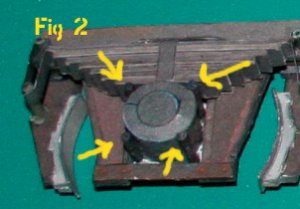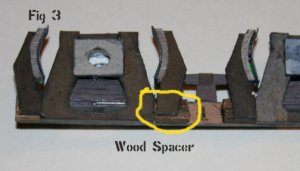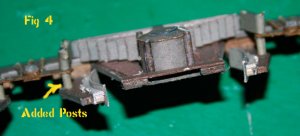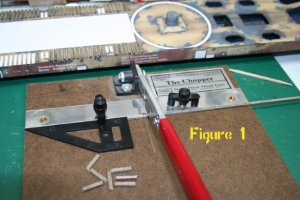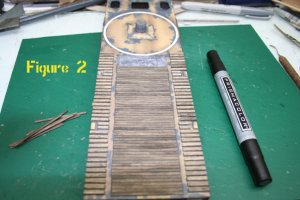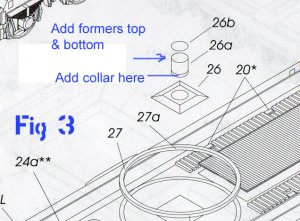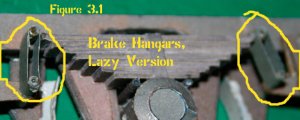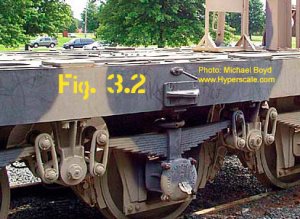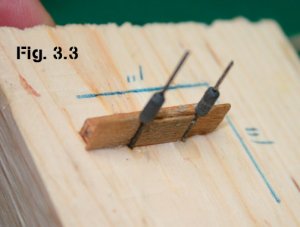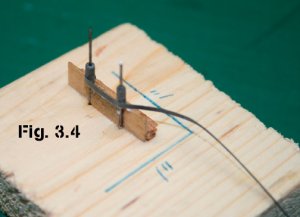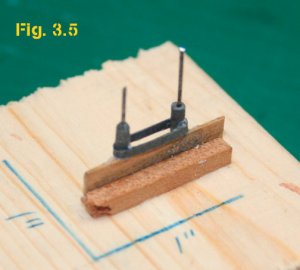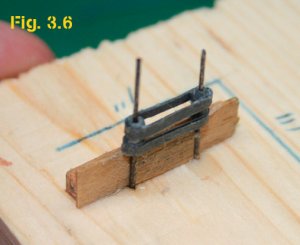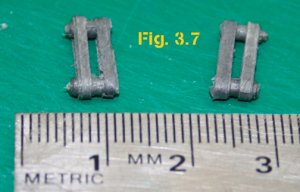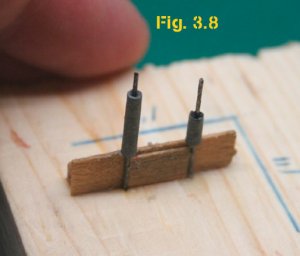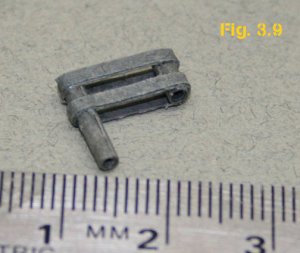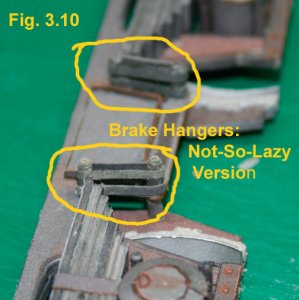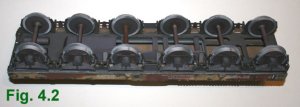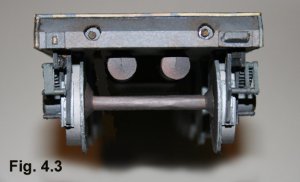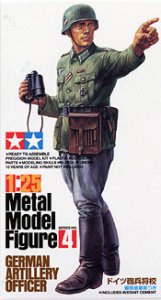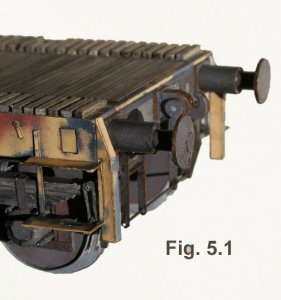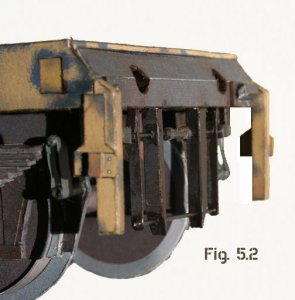"The Great Undertaking" -- GPM's Leopold Rail Gun -- Post #1
Ten days ago, I displayed some paper models at an IPMS meet in Milwaukee, Wisconsin (see my "Milwaukee IPMS Contest Report" under "NEWS.") One of the things that attracted the most attention was an unbuilt copy of GPM's "Leopold" Rail Gun in 1/25 scale. All that attention inspired me to build that kit for next year's IPMS meet. This is the first report on the project. I'll add more posts as the Great Undertaking progresses.
I've never built a paper model this large. But looking at the kit, it appears that it will require no skills or techniques I haven't already used on smaller (saner) models. So here goes.
I've started with one of the two rail cars--specially-built flat cars--that carry the cannon. The first step is to assemble the leaf springs. Choose your card thickness carefully here and do some test fitting and experimenting. Part 1c is the vertical band that fits over each spring. It should reach just to the bottom of the leaf spring. If it doesn't, your springs are too thick. I'm not sure what thickness card I used and I don't have a way to accurately measure it, so you'll have to work it out by experimenting.
The two side frames (Fig 1) go together fairly easily. You'll need extra-heavy card for the side frames and brake frames, and for the car body when you get that far. Picture framing matte board seems to be about right--somewhere around 1.5 mm or a little less than a 1/16" thick. (See below: A Note about Heavy Card.") The first side frame took me about a week of evenings. The second is going a bit faster. They're big; that's a six-inch ruler. I made a few modifications:
Four bolts secure each of the wheel bearing cases. The ones supplied in the kit (parts 1k) are too short. They should be as tall as the side of the bearing case. Scan a strip of 12 parts 1k, enlarge them to 190%, and print them on good quality inkjet paper or matte photo paper (20-24 lb). Then roll them and attach them according to the instructions. (Fig 2)
The kit instructions show the brake brackets (parts 2aP & 2aL) attaching directly to the back of the side frame. But if you mount them that way, they won't line up with the wheel treads--they'll be too far outboard. I made spacer blocks from 1/8-inch thick basswood. (Fig 3) Then I built up one wheel and axle and used that as a guide to position the brake brackets.
With the brakes positioned farther inboard, you'll have to add extra posts to the brake pivots (see Fig 4). I don't have any good photos, drawings, or models of a 1940s European rail bogie, but this looks about right and it makes sense. If you have better information on what this prototype assembly SHOULD look like, please post it here.
Once I've finished the other sideframe, I'll move on to building the flatcar.
I expect (I hope) my model photo skills will improve as well.
Stay tuned.
No worries,
--David
A Note about Heavy Card:
The ideal card stock for the laminated parts marked "**" seems to be about 1.3-1.5 mm thick. I built the first rail car with a sheet of heavy (about 1.4 mm) card I bought from Lighthouse Model Art. I think Ralf got it from Fly Model. (Lighthouse is, sad to say, no longer in busiess. We miss you, Ralf.) For the underframe on the second rail car, I used picture matte board and found it just a hair thicker but much more dense and much harder to work with. For the rest of the kit, I'll snitch heavy card from some of my unbuilt Fly Model kits. For those kits, I can substitute scrap and scrounged material (for fuselage formers and wing spars). Live and learn.
Ten days ago, I displayed some paper models at an IPMS meet in Milwaukee, Wisconsin (see my "Milwaukee IPMS Contest Report" under "NEWS.") One of the things that attracted the most attention was an unbuilt copy of GPM's "Leopold" Rail Gun in 1/25 scale. All that attention inspired me to build that kit for next year's IPMS meet. This is the first report on the project. I'll add more posts as the Great Undertaking progresses.
I've never built a paper model this large. But looking at the kit, it appears that it will require no skills or techniques I haven't already used on smaller (saner) models. So here goes.
I've started with one of the two rail cars--specially-built flat cars--that carry the cannon. The first step is to assemble the leaf springs. Choose your card thickness carefully here and do some test fitting and experimenting. Part 1c is the vertical band that fits over each spring. It should reach just to the bottom of the leaf spring. If it doesn't, your springs are too thick. I'm not sure what thickness card I used and I don't have a way to accurately measure it, so you'll have to work it out by experimenting.
The two side frames (Fig 1) go together fairly easily. You'll need extra-heavy card for the side frames and brake frames, and for the car body when you get that far. Picture framing matte board seems to be about right--somewhere around 1.5 mm or a little less than a 1/16" thick. (See below: A Note about Heavy Card.") The first side frame took me about a week of evenings. The second is going a bit faster. They're big; that's a six-inch ruler. I made a few modifications:
Four bolts secure each of the wheel bearing cases. The ones supplied in the kit (parts 1k) are too short. They should be as tall as the side of the bearing case. Scan a strip of 12 parts 1k, enlarge them to 190%, and print them on good quality inkjet paper or matte photo paper (20-24 lb). Then roll them and attach them according to the instructions. (Fig 2)
The kit instructions show the brake brackets (parts 2aP & 2aL) attaching directly to the back of the side frame. But if you mount them that way, they won't line up with the wheel treads--they'll be too far outboard. I made spacer blocks from 1/8-inch thick basswood. (Fig 3) Then I built up one wheel and axle and used that as a guide to position the brake brackets.
With the brakes positioned farther inboard, you'll have to add extra posts to the brake pivots (see Fig 4). I don't have any good photos, drawings, or models of a 1940s European rail bogie, but this looks about right and it makes sense. If you have better information on what this prototype assembly SHOULD look like, please post it here.
Once I've finished the other sideframe, I'll move on to building the flatcar.
I expect (I hope) my model photo skills will improve as well.
Stay tuned.
No worries,
--David
A Note about Heavy Card:
The ideal card stock for the laminated parts marked "**" seems to be about 1.3-1.5 mm thick. I built the first rail car with a sheet of heavy (about 1.4 mm) card I bought from Lighthouse Model Art. I think Ralf got it from Fly Model. (Lighthouse is, sad to say, no longer in busiess. We miss you, Ralf.) For the underframe on the second rail car, I used picture matte board and found it just a hair thicker but much more dense and much harder to work with. For the rest of the kit, I'll snitch heavy card from some of my unbuilt Fly Model kits. For those kits, I can substitute scrap and scrounged material (for fuselage formers and wing spars). Live and learn.



